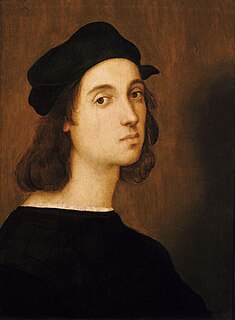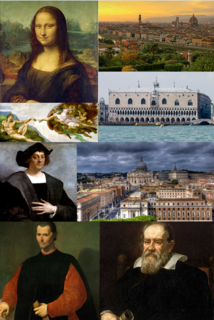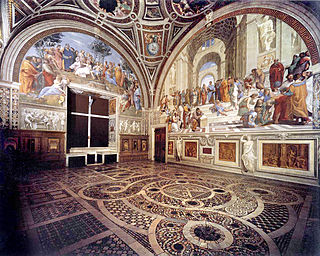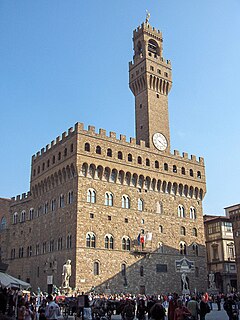X
| | This section is empty. You can help by adding to it. (February 2022) |
This is an alphabetical index of articles related to the Renaissance .
Académie de musique et de poésie - Accademia degli Infiammati - Accademia Filarmonica di Verona - Accademia Fiorentina - Age of Discovery - Air de cour - Aldine Press - Allegory in Renaissance literature - Allemande - Almain rivet - Andalusian cadence - Antwerp Mannerism - Antwerp school - Arquebus - Ars historica - Art patronage of Julius II - Artists of the Tudor court
Ballo - Baluster - Bardini Gardens - Basse danse - Bastion fort - Bicinium - Bolognese School - Bolognese Swordsmanship - Bonfire of the vanities - Brancacci Chapel - Branchwork - Brick Renaissance - Broken consort - Brussels tapestry - Burgonet - Burgundian School
Camera degli Sposi - Canary dance - Cangiante - Cantore al liuto - Capriccio (art) - Carmen figuratum - Carnival song - Carracks black sword - Catherine de' Medici's building projects - Catherine de' Medici's court festivals - Catherine de' Medici's patronage of the arts - Centrifugal pump - Certosina - Chamber of rhetoric - Chariot clock - Châteaux of the Loire Valley - Chiaroscuro - Chinese porcelain in European painting - Christian Humanism - Cinquecento - Cinquedea - The Civilization of the Renaissance in Italy - Classical republicanism - Colascione - Commesso - Consort of instruments - Consort song - Continuity thesis - Copernican heliocentrism - Copernican Revolution - Cordial (medicine) - Cornamuse - Corseque - Cortile del Belvedere - Courante - Court painter - Cresset - Cross-strung harp - Crumhorn - Cultural references to Leonardo da Vinci - Culverin - Cutwork - Cyclic mass - Czech Renaissance architecture
Dancing mania - Danube school - Dardanelles Gun - David (Donatello) - De pictura - De re aedificatoria - Demi-culverin - Desco da parto - Diamond vault - Donor portrait - Drawing room - Dutch and Flemish Renaissance painting - Dutch gable - Dutch Renaissance and Golden Age literature
Early Netherlandish painting - Elizabethan and Jacobean furniture - Elizabethan architecture - Elizabethan era - Elizabethan leisure - Elizabethan literature - English Madrigal School - English Renaissance - English Renaissance theatre - Estoc - Europa regina - European colonization of the Americas - Evolutionary ideas of the Renaissance and Enlightenment
Fall of Constantinople - Figura serpentinata - Flame-bladed sword - Flemish painting - Florence - Florentine Camerata - Florentine citron - Florentine painting - Florin - Folly (allegory) - Forlivese school of art - Franco-Flemish School - French Renaissance - French Renaissance architecture - French Renaissance literature - Fresco - Frottola
Gallery of Sistine Chapel ceiling - Galliard - Gardens of the French Renaissance - Gavotte - Geohumoral theory - German Renaissance - Ghent-Bruges school - Ghisi Shield - Giant order - Gnome - Gobelins Manufactory - Gothic boxwood miniature - Grand manner - Grands rhétoriqueurs - Greek scholars in the Renaissance - Greenwich armour - Guldengroschen
Halberd - Hand cannon - Harpsichord - Harpsichord-viola - Hedge maze - Henry II style - Herrerian style - High Renaissance - Hispano-Flemish style - Hispano-Moresque ware - History of Italian Renaissance domes - History of science in the Renaissance - Holbein carpet - Hours of James IV of Scotland - Hours of Lorenzo de' Medici - House of Borgia - House of Medici - House of Sforza - Humanism in France - The Hunt of the Unicorn
I quattro libri dell'architettura - Ideal city - Ideal town - Illusionism (art) - Illusionistic ceiling painting - Imprimatura - Incunable - Intercolumniation - Intermedio - Isenheim Altarpiece - Italian city-states - Italian Renaissance - Italian Renaissance garden - Italian Renaissance interior design - Italian Renaissance painting - Italian Wars
Katzbalger - Kepler's laws of planetary motion - Knot garden - Koncerz
Landsknecht - Lantern shield - The Last Judgment - The Last Supper - Laurentian Library - Legal humanists - Leonardeschi - Leonardo da Vinci - Leonardo's robot - Libro de' Disegni - Limoges enamel - Lira da braccio - Little Masters - Lives of the Most Excellent Painters, Sculptors, and Architects - Lochaber axe - Lombard (gun) - Long gallery - Longsword - Lotto carpet - Lublin Renaissance - Lucan portrait of Leonardo da Vinci Lucerne hammer - Lute song
Madia (furniture) - Madrigal - Madrigal comedy - Madrigale spirituale - Maiolica - Mannerism - Mannerist architecture and sculpture in Poland - Mariner's astrolabe - Mascherata - Maximilian armour - Medical Renaissance - Mensural notation - Messer (weapon) - Michelangelo - Michelangelo and the Medici - Millefleur - Monster of Ravenna - Moresca - Moresche - Moresque - Motet - Motet-chanson - Museo Nazionale Scienza e Tecnologia Leonardo da Vinci - Music in the Elizabethan era - Musica reservata - Musique mesurée - Musket
Natural magic - Neostoicism - New Learning - Northern Mannerism - Northern Renaissance
Oil painting - Oriental carpets in Renaissance painting - Ostrich Egg Globe - Overdoor - Ovetari Chapel
Palazzo Chiericati - Palladian architecture - Palladian villas of the Veneto - Palmanova - Paragone - Paraphrase mass - Paris in the 16th century - Parody mass - Pastel - Pastiglia - Pastrana Tapestries - Pavane - Pazzi conspiracy - Period eye - Personal life of Leonardo da Vinci - Perspective - Petrarchan sonnet - Piano nobile - Picaresque novel - Pietra dura - Pietra serena - Pike (weapon) - Pinxit - Piva (dance) - Plackart - Plaquette - Plate armour - Plateresque - Platonic Academy (Florence) - Platonism in the Renaissance - Pléiade - Poignard - Polymath - Polyphony - Polyptych - Ponte Vecchio, Bassano - Portrait painting in Scotland - Portuguese Renaissance - Prestezza - Primavera (Botticelli) - Printing press - Prodigy house - Pseudo-Kufic - Purism (Spanish architecture) - Putto
Rackett - Raphael - Raphael Cartoons - Raphael Rooms - Rebec - Recitative - Reichsthaler - Rapier - Relazione - Renaissance - Renaissance architecture - Renaissance architecture in Central and Eastern Europe - Renaissance architecture in Portugal - Renaissance architecture of Toulouse - Renaissance art - Renaissance castle in Galanta - Renaissance dance - Renaissance humanism - Renaissance humanism in Northern Europe - Renaissance in Croatia - Renaissance in Poland - Renaissance in Scotland - Renaissance in the Low Countries - Renaissance Latin - Renaissance literature - Renaissance magic - Renaissance music - Renaissance Papacy - Renaissance philosophy - Renaissance reenactment - Renaissance Revival architecture - Renaissance Studies - Renaissance technology - Ribauldequin - Ricercar - Road of Weser Renaissance - Rodeleros - Roman Renaissance - Roman School - Romanism (painting) - Rondel dagger - Roof lantern - Rustication (architecture)
Sackbut - Sacra conversazione - Saint-Porchaire ware - Sala dei Cento Giorni - Saltarello - San Giorgio Maggiore (church), Venice - Sassetti Chapel - Schlüsselfelder Ship - The School of Athens - School of Ferrara - School of Fontainebleau - The School of Night - Science and inventions of Leonardo da Vinci - Scientific Revolution - Scottish Renaissance painted ceilings - Scottish Royal tapestry collection - Sculpture in the Renaissance Period - Scythe sword - Sforza Hours - Sforzinda - Sfumato - Sgabello - Sgraffito - William Shakespeare - Shakespearean comedy - Shakespearean dance - Shakespearean history - Shakespeare's plays - Shakespearean tragedy - Sienese School - Signoria - Signoria of Florence - Signoria of Venice - Sinopia - Sistine Chapel - Sistine Chapel ceiling - Snaplock - Soggetto cavato - Souterliedekens - Spada da lato - Spalliera - Spanish Golden Age - Spanish Renaissance - Spanish Renaissance architecture - Spanish Renaissance literature - St. Peter's Basilica - Stiletto - Stipo a bambocci - Strapwork - Strolling players - Studiolo of the Palazzo Belfiore - Summa de arithmetica - Swedish Reformation and Renaissance literature - Swiss dagger - Swiss degen - Swiss Guard - Swiss mercenaries
Tapestry - Tarot - Teatro Olimpico - Tercio - Text declamation - Theatrum Orbis Terrarum - Themes in Italian Renaissance painting - Tiento - Tondo (art) - Tornabuoni Chapel - Tourdion - Transition from Renaissance to Baroque in instrumental music - Trattato della pittura - Trecento - The Triumph of Fame - Tudor architecture - Tudor period - Tuileries Garden - Tuileries Palace - Tuscan order
Valois Tapestries - Vatican loggias - Venetian painting - Venetian Patent Statute - Venetian polychoral style - Venetian red - Venetian Renaissance - Venetian Renaissance architecture - Venetian School (music) - Venetian window - Vihuela - Villa Capra "La Rotonda" - Villa Cornaro - Villa d'Este - Villancico - Villanella - Viol - Viola organista - Virelai - Virginals - Vitruvian Man - Volta (dance)
Waddesdon Bequest - Wars of the Roses - Wernigerode Armorial - Weser Renaissance - Wet-on-wet - William Shakespeare - Word painting
| | This section is empty. You can help by adding to it. (February 2022) |
| | This section is empty. You can help by adding to it. (February 2022) |
Commentators on Aristotle - Composers - English Renaissance composers - English Renaissance theatres - Figures - Humanists - Structures - Works by Leonardo da Vinci

Mannerism, which may also be known as Late Renaissance, is a style in European art that emerged in the later years of the Italian High Renaissance around 1520, spreading by about 1530 and lasting until about the end of the 16th century in Italy, when the Baroque style largely replaced it. Northern Mannerism continued into the early 17th century.
This is an alphabetical index of articles related to painting.

The Renaissance is a period in European history marking the transition from the Middle Ages to modernity and covering the 15th and 16th centuries, characterized by an effort to revive and surpass ideas and achievements of classical antiquity. It occurred after the Crisis of the Late Middle Ages and was associated with great social change. In addition to the standard periodization, proponents of a "long Renaissance" may put its beginning in the 14th century and its end in the 17th century.

Renaissance architecture is the European architecture of the period between the early 15th and early 16th centuries in different regions, demonstrating a conscious revival and development of certain elements of ancient Greek and Roman thought and material culture. Stylistically, Renaissance architecture followed Gothic architecture and was succeeded by Baroque architecture. Developed first in Florence, with Filippo Brunelleschi as one of its innovators, the Renaissance style quickly spread to other Italian cities. The style was carried to Spain, France, Germany, England, Russia and other parts of Europe at different dates and with varying degrees of impact.

Raffaello Sanzio da Urbino, better known as Raphael, was an Italian painter and architect of the High Renaissance. His work is admired for its clarity of form, ease of composition, and visual achievement of the Neoplatonic ideal of human grandeur. Together with Leonardo da Vinci and Michelangelo, he forms the traditional trinity of great masters of that period.

Renaissance art is the painting, sculpture, and decorative arts of the period of European history known as the Renaissance, which emerged as a distinct style in Italy in about AD 1400, in parallel with developments which occurred in philosophy, literature, music, science, and technology. Renaissance art took as its foundation the art of Classical antiquity, perceived as the noblest of ancient traditions, but transformed that tradition by absorbing recent developments in the art of Northern Europe and by applying contemporary scientific knowledge. Along with Renaissance humanist philosophy, it spread throughout Europe, affecting both artists and their patrons with the development of new techniques and new artistic sensibilities. For art historians, Renaissance art marks the transition of Europe from the medieval period to the Early Modern age.

The Italian Renaissance was a period in Italian history covering the 15th and 16th centuries. The period is known for the initial development of the broader Renaissance culture that spread across Europe and marked the transition from the Middle Ages to modernity. Proponents of a "long Renaissance" argue that it started around the year 1300 and lasted until about 1600. In some fields, a Proto-Renaissance, beginning around 1250, is typically accepted. The French word renaissance means 'rebirth', and defines the period as one of cultural revival and renewed interest in classical antiquity after the centuries during what Renaissance humanists labelled as the "Dark Ages". The Renaissance author Giorgio Vasari used the term rinascita 'rebirth' in his Lives of the Most Excellent Painters, Sculptors, and Architects in 1550, but the concept became widespread only in the 19th century, after the work of scholars such as Jules Michelet and Jacob Burckhardt.

In art history, the High Renaissance was a short period of the most exceptional artistic production in the Italian states, particularly Rome, capital of the Papal States, and in Florence, during the Italian Renaissance. Most art historians state that the High Renaissance started around 1495 or 1500 and ended in 1520 with the death of Raphael, although some say the High Renaissance ended about 1525, or in 1527 with the Sack of Rome by the army of Charles V, Holy Roman Emperor, or about 1530. The best-known exponents of painting, sculpture and architecture of the High Renaissance include Leonardo da Vinci, Michelangelo, Raphael, and Bramante. In recent years, the use of the term has been frequently criticized by some academic art historians for oversimplifying artistic developments, ignoring historical context, and focusing only on a few iconic works.

The Northern Renaissance was the Renaissance that occurred in Europe north of the Alps. From the last years of the 15th century, its Renaissance spread around Europe. Called the Northern Renaissance because it occurred north of the Italian Renaissance, this period became the German, French, English, Low Countries, Polish Renaissances and in turn other national and localized movements, each with different attributes.

The English Renaissance was a cultural and artistic movement in England from the early 16th century to the early 17th century. It is associated with the pan-European Renaissance that is usually regarded as beginning in Italy in the late 14th century. As in most of the rest of northern Europe, England saw little of these developments until more than a century later. Renaissance style and ideas, however, were slow to penetrate England, and the Elizabethan era in the second half of the 16th century is usually regarded as the height of the English Renaissance. However, many scholars see its beginnings in the early 16th century, during the reign of Henry VIII.

Since ancient times, Greeks, Etruscans and Celts have inhabited the south, centre and north of the Italian peninsula respectively. The very numerous rock drawings in Valcamonica are as old as 8,000 BC, and there are rich remains of Etruscan art from thousands of tombs, as well as rich remains from the Greek colonies at Paestum, Agrigento and elsewhere. Ancient Rome finally emerged as the dominant Italian and European power. The Roman remains in Italy are of extraordinary richness, from the grand Imperial monuments of Rome itself to the survival of exceptionally preserved ordinary buildings in Pompeii and neighbouring sites. Following the fall of the Roman Empire, in the Middle Ages Italy, especially the north, remained an important centre, not only of the Carolingian art and Ottonian art of the Holy Roman Emperors, but for the Byzantine art of Ravenna and other sites.

The Palazzo Vecchio is the town hall of Florence, Italy. It overlooks the Piazza della Signoria, which holds a copy of Michelangelo's David statue, and the gallery of statues in the adjacent Loggia dei Lanzi.

The French Renaissance was the cultural and artistic movement in France between the 15th and early 17th centuries. The period is associated with the pan-European Renaissance, a word first used by the French historian Jules Michelet to define the artistic and cultural "rebirth" of Europe.

The cultural and artistic events of Italy during the period 1500 to 1599 are collectively referred to as the Cinquecento, from the Italian for the number 500, in turn from millecinquecento, which is Italian for the year 1500. Cinquecento encompasses the styles and events of the High Italian Renaissance, Mannerism and some early exponents of the Baroque-style.

Florentine painting or the Florentine School refers to artists in, from, or influenced by the naturalistic style developed in Florence in the 14th century, largely through the efforts of Giotto di Bondone, and in the 15th century the leading school of Western painting. Some of the best known painters of the earlier Florentine School are Fra Angelico, Botticelli, Filippo Lippi, the Ghirlandaio family, Masolino, and Masaccio.

Italian Renaissance painting is the painting of the period beginning in the late 13th century and flourishing from the early 15th to late 16th centuries, occurring in the Italian Peninsula, which was at that time divided into many political states, some independent but others controlled by external powers. The painters of Renaissance Italy, although often attached to particular courts and with loyalties to particular towns, nonetheless wandered the length and breadth of Italy, often occupying a diplomatic status and disseminating artistic and philosophical ideas.
The decade of the 1490s in art involved some significant events.
The decade of the 1480s in art involved some significant events.

Panagiotis Doxaras (1662–1729) also known as Panayiotis Doxaras, was an author and painter. He was a prolific member of the Heptanese School. He was influenced by early members of the movement namely: Elias Moskos, Theodoros Poulakis, Stephanos Tzangarolas, Spyridon Sperantzas and Victor. The Heptanese School evolved during the Baroque period and continued into the Late Baroque or Rococo. Doxaras’s son Nikolaos Doxaras continued the artistic movement into the Neoclassical era. Both Panagiotis and his son Nikolaos Doxaras refined the school. The school was heavily influenced by the Venetian Style. The Heptanese School also influenced Italian painting. Other artists Doxaras influenced were Nikolaos Kantounis. Panagioti’s teacher was famous painter Leos Moskos. He studied with him while he was in Venice. Doxaras painted notable portraits of Johann Matthias von der Schulenburg. He introduced Maniera Italiana to the Heptanese School drastically changing the style from the Maniera Greca. He is considered the father of the Greek Rococo and the Modern Greek Enlightenment in art.
The following outline is provided as an overview of and topical guide to the Renaissance: